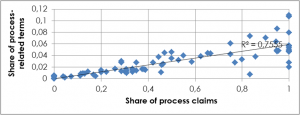Extended Abstract – TECHMINING FOR MoT AND CTI session at “1st Global TechMining Conference” 2011
Authors: Jan M. Gerken1 and Martin G. Moehrle1, Institute of Project Management and Innovation
Technological innovations have become very important, as technological innovations and their protection have been considered as the most important dimension of regimes of appropriability (Teece, 1986). An important driver for technological innovations is the evolution of technology, for which several theories have been proposed. A well-known theory was introduced by Utterback and Abernathy (1975). They described a typical relationship between the rate of product innovations and process innovations. They observed a shift from product innovations to process innovations over time. Based on this, Teece (1986) distinguished in a Kuhnian (Kuhn, 2007) notion between two phases. Additionally, Teece (1986) emphasized the meaning of complementary assets, as complementary assets are critical for business success.
In this context, business method innovations deserve special attention, as they bundle several aspects of complementary assets (e.g. services and distribution channels). The meaning of such complementary assets is reinforced by the fact that for approx. 10 years business methods can be protected by patents which leads to a new quality of complementary assets. The questions are whether the model of Utterback and Abernathy is still up to date, whether there is an evolution of business method patents beside the technological patents and if so which course do business method patents take.
We investigated the interdependencies between technological innovations and business methods, especially the emergence of innovative business methods. For this purpose, we created a case study in the field of RFID technology, in which we analysed both technological and business method patents. Business method patents have been widespread discussed with regard to their legal status and their legal or actual enforceability. But their managerial implications, their contributions to technology monitoring and the necessity to monitor business method patents have been only rarely discussed. This seems to be surprising as the total number of business method patents increases steadily. Due to this, they might be a promising information source for technology and competitor monitoring, even though non-technical complementary assets might be a more and more important driver of economic success.
For our study we distinguished between technological product patents, technological process patents and business method patents. For the first two types, we defined a new propensity-to-process measure, which is based on the occurrence of process-related terms in the claims, as we found a close relationship between process-related terms and the share of process claims in a random sample of 100 patents in the field of RFID (Figure 1). For the third type, we examined whether a patent is classified to US patent class 705, which is the original class for business method patents.

Figure 1: Relationship between share of process claims and the share of process-related terms in the claims
Based on these findings, we investigated the courses of the propensity to innovate products, processes and business methods (Figure 2).

Figure 2: Courses of the propensity to innovate products (red), processes (dashed) and business methods (green)
From our results we conclude that there are indeed two traditional waves of technological innovations: product and process innovations. But there is a third wave: the business method wave. Indeed, the type of waves differ in their scaling this might be due to the companies’ patenting behaviour related to the different types of innovations (see e.g. Arundel and Kabla, 1998), to the role of RFID within the patents, as they also might only be mentioned as a part of another system, but also to methodological limitations, as our measures have to be advanced.
Our data suggests that the business method wave may be an even longer lasting wave, as technological saturation is reached before business method saturation. Some companies have already reacted on this wave, but most companies still focus on technological innovations. For those companies, business method innovations are a great prospective challenge for their business. At the same time, business method patents may be a promising information source on innovative business methods in the future.
Keywords: Business method innovation, technological evolution and monitoring, patent analysis
Arundel, A., Kabla, I., 1998. What percentage of innovations are patented? Empirical estimates for European firms. Research Policy 27, 127-141.
Kuhn, T.S., 2007. Die Struktur wissenschaftlicher Revolutionen. Suhrkamp, Frankfurt am Main.
Teece, D.J., 1986. Profiting from technological innovation: Implications for integration, collaboration, licensing and public policy. Research Policy 15, 285-305.
Utterback, J.M., Abernathy, W.J.,
